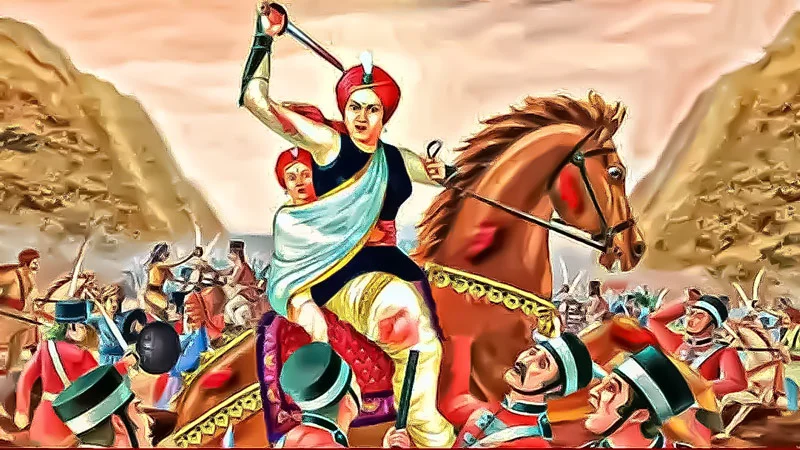The story behind Rani Laxmi Bai Real Name, also known as the Queen of Jhansi, is one of courage, patriotism, and sacrifice. A pivotal figure in India’s first war of independence in 1857, her journey is marked by resilience and unwavering determination. While the world knows her as Rani Laxmi Bai, her real name was Manikarnika Tambe, lovingly called Manu. Born into a humble family and rising to become a fearless leader, Rani Laxmi Bai’s story inspires generations.
In 1828, Manikarnika was born in the ghats of Varanasi. Her father, Moropanth, and Peshwa Bajirao II raised her in Bithoor. She is a favourite of the Peshwa, and he has brought her up with a lot of love. One day, Dixit Ji of Jhansi spots her facing a ferocious tiger fearlessly. Impressed, he asks Peshwa for her hand in marriage with Maharaja of the Maratha-ruled princely state of Jhansi, Gangadhar Rao.
Dixit Ji knows that the British are eyeing Jhansi and want to annex the kingdom. He realises that her brave persona would play a crucial role in giving a tough fight to the British. The marriage takes place, and as per the tradition, the king gives her a new name – ‘Laxmibai’ (or Lakshmi Bai). All these developments upset Gangadhar’s brother, Sadashiv Rao. He is friendly with the British and wants to usurp the throne.
Read Also: What You Must Know About Grandmother of Pandavas Biography
Early Life of Manikarnika Tambe
Manikarnika Tambe, later known as Rani Lakshmibai, was born on November 19, 1828, in Varanasi, Uttar Pradesh, to Moropant Tambe and Bhagirathi Sapre. Her father was a court advisor, and her mother was a deeply spiritual woman. Manikarnika’s early life was shaped by her upbringing in a household where patriotism and cultural values were cherished.
Tragically, Bhagirathi Sapre passed away when Manikarnika was very young. Despite this loss, her father ensured that she received an education and training in martial arts, horseback riding, and sword fighting—skills that would later define her legendary status.
The Journey to Becoming Rani Laxmi Bai
Manikarnika’s life took a pivotal turn when she married Maharaja Gangadhar Rao Newalkar, the ruler of Jhansi, in 1842. Upon her marriage, she was renamed Laxmi Bai, a symbol of prosperity and strength. The couple adopted a son, Damodar Rao, after the untimely death of their biological child.
The joy of family life was short-lived, as Maharaja Gangadhar Rao passed away in 1853. This tragedy marked the beginning of her battle against the British East India Company, which refused to recognise Damodar Rao as the rightful heir to the Jhansi throne. Under Lord Dalhousie’s Doctrine of Lapse, the British annexed Jhansi, setting the stage for Laxmi Bai’s resistance.
Rani Laxmi Bai and the Indian Rebellion of 1857
The Indian Rebellion 1857, also known as the First War of Independence, saw Rani Laxmi Bai emerge as a fearless leader. Her refusal to surrender to Jhansi without a fight symbolised defiance against British rule. With the support of freedom fighters like Tatya Tope, Nana Sahib, and Rao Sahib, Rani Laxmi Bai formed the Jhansi Regiment, training men and women to defend their homeland.
One of her most iconic moments of resistance was her daring escape from Jhansi on horseback with her adopted son, Damodar Rao, tied to her back. This bravery demonstrated her determination to protect her kingdom and her son.
Key Allies in the Fight
Rani Laxmi Bai’s struggle was supported by notable figures in India’s fight for freedom, including:
Tatya Tope: Her trusted ally, who provided military support.
Nana Sahib: A key leader in the rebellion.
Gulam Gaus Khan: A brave commander who fought valiantly for Jhansi.
Together, they formed a formidable resistance against the British forces, inspiring thousands to join the freedom movement.
The Battle of Gwalior
In June 1858, Rani Laxmi Bai’s forces clashed with the British under Sir Hugh Rose in the Battle of Gwalior. Despite being heavily outnumbered, Rani Laxmi Bai fought courageously, leading her army from the front. She disguised herself as a soldier, wielding swords in both hands and charged fearlessly into battle.
On June 18, 1858, Rani Laxmi Bai was fatally wounded in combat. Her final wish was that her body not be captured by the British, and her loyal followers ensured her cremation on the battlefield. Her martyrdom solidified her legacy, symbolising India’s fight for freedom.
Read Also: What You Must Know About Nawaf Salam Biography
Legacy of Rani Laxmi Bai
Rani Laxmi Bai’s impact on Indian history is immeasurable. Her courage inspired countless freedom fighters, including Bhagat Singh, Mangal Pandey, and Lala Lajpat Rai. Her life story has been immortalised in literature, cinema, and folklore, reminding us of the sacrifices made for independence.
Notable Memorials and Tributes:
- Rani Jhansi Marg: Roads and schools across India are named in her honour.
- Rani Lakshmi Bai Biography: Her story is a part of Indian school curriculums, ensuring her bravery inspires future generations.
- Cultural Representations: From plays and poems to movies like Kangana Ranaut’s Manikarnika: The Queen of Jhansi, her life captivates audiences.
The Symbol of Womanhood and Empowerment
As a woman, Rani Laxmi Bai shattered societal norms, proving that leadership and bravery are not confined to gender. Her life serves as a testament to the strength of women, inspiring movements for gender equality and empowerment.
Read Also: Amelia Earhart Biography: The Legacy of a Trailblazing Female Pilot
Conclusion
The Rani Laxmi Bai Real Name, Manikarnika Tambe, is a name that resonates with courage, sacrifice, and patriotism. Her journey from a young girl in Varanasi to the Queen of Jhansi is a story of resilience and unwavering commitment to her people and land. As we celebrate her legacy, Rani Laxmi Bai remains a beacon of hope and inspiration for future generations.
Her life reminds us that authentic leadership is about standing up for what is right despite insurmountable odds. Rani Laxmi Bai’s name is forever etched in the annals of Indian history as a symbol of India’s indomitable spirit.
